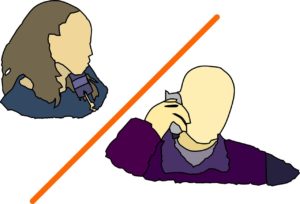If you find yourself avoiding certain situations or objects more than usual, you might be among the estimated 19 million adults in the United States affected by specific phobias. Feeling intense fear or panic, experiencing physical symptoms like sweating or trembling, and finding it challenging to control your reactions are all signs that could indicate a phobia. Understanding these warning signals is the first step in addressing and managing this common mental health concern.
Excessive and Uncontrollable Fear
 If you find yourself experiencing overwhelming and uncontrollable fear in certain situations, it’s vital to recognize these feelings and seek help. Therapy options are available to assist you in managing your phobia effectively. Cognitive-behavioral therapy (CBT) is a common approach that can help you understand and change the thoughts and behaviors contributing to your fear.
If you find yourself experiencing overwhelming and uncontrollable fear in certain situations, it’s vital to recognize these feelings and seek help. Therapy options are available to assist you in managing your phobia effectively. Cognitive-behavioral therapy (CBT) is a common approach that can help you understand and change the thoughts and behaviors contributing to your fear.
Exposure therapy is another effective method where you gradually face your fears in a controlled environment, helping you build confidence and reduce anxiety over time.
In addition to therapy, coping strategies play an important role in dealing with phobias. Deep breathing exercises, mindfulness techniques, and progressive muscle relaxation can help you stay calm when confronted with your fears. It’s also beneficial to educate yourself about your phobia, as understanding the triggers and responses can empower you to confront them more effectively.
Avoidance Behavior
Experiencing avoidance behavior, such as actively steering clear of situations or places that trigger your phobia, can reinforce feelings of fear and anxiety. When you consistently avoid these triggers, it may seem like a temporary relief, but in reality, it can exacerbate your phobia over time.
Coping mechanisms are essential in addressing avoidance behavior associated with phobias. By gradually exposing yourself to the feared stimuli through techniques like gradual desensitization, you can learn to confront your fears in a controlled manner.
Therapy options, such as cognitive-behavioral therapy (CBT), can also provide you with the tools to challenge negative thought patterns and gradually confront your fears. Avoidance behavior not only impacts your individual well-being but can also strain your relationships and social interactions.
Loved ones may struggle to understand your avoidance patterns, leading to misunderstandings and isolation. Seeking professional help and fostering open communication with those around you can help navigate the challenges avoidance behavior presents in relationships and social settings.
Physical Symptoms
Physical symptoms accompanying a phobia can manifest in various ways, impacting both your mental and physical well-being. When faced with the object of your fear, you may experience sweating and shaking. These physical reactions are your body’s way of responding to the perceived threat, preparing you for a potential danger.
Sweating excessively can be uncomfortable and embarrassing, leading to increased anxiety. Shaking or trembling may make you feel weak and out of control, adding to the distress caused by the phobia.
Additionally, nausea and dizziness are common physical symptoms associated with phobias. The feeling of nausea can be overwhelming, making it difficult to focus on anything other than your discomfort. Dizziness can further exacerbate your anxiety, making you feel lightheaded and unsteady.
These physical manifestations of fear can be distressing, intensifying the emotional turmoil you may already be experiencing. It’s essential to recognize these symptoms as part of your phobia and seek appropriate support to manage them effectively.
Immediate Anxiety Response
When confronted with your phobia, your immediate anxiety response can trigger a range of intense emotions and physical reactions. Phobia triggers can vary from person to person, but the feelings of fear, panic, and dread are common when faced with the source of your fear.
Your heart may race, palms may sweat, and breathing may become rapid and shallow. These automatic reactions can be overwhelming, making it challenging to cope with the situation.
Recognizing phobia symptoms is the first step towards managing your anxiety response. It’s vital to acknowledge your fear and understand how it manifests in your body and mind. Developing coping strategies can help you navigate these intense feelings.
Techniques such as deep breathing, positive self-talk, and mindfulness can assist in calming your immediate anxiety response.
If your phobia significantly impacts your daily life and well-being, seeking help from a mental health professional is important. They can provide therapy, such as exposure therapy or cognitive-behavioral therapy, tailored to help you overcome your phobia and manage your anxiety response effectively.
Distress or Panic Attacks
If faced with distress or panic attacks related to your phobia, recognizing the signs and understanding their triggers can be crucial steps in managing and overcoming these intense experiences. Coping strategies are essential in navigating these challenging moments. Breathing exercises, mindfulness techniques, and grounding exercises can help you regain control during a panic attack. Therapy options such as cognitive-behavioral therapy (CBT) or exposure therapy can assist in addressing the root causes of your phobia and reducing the frequency and intensity of distressing episodes.
Understanding triggers is key to managing symptoms. Keep a journal to track situations or stimuli that lead to distress or panic attacks. Once you identify these triggers, you can work with a therapist to develop personalized strategies to cope with them effectively.
Remember that seeking professional help isn’t a sign of weakness but a proactive step towards improving your mental well-being. By actively engaging in coping mechanisms and therapy, you can gradually work towards overcoming the distress and panic associated with your phobia.
Disruption of Daily Activities
How can the disruption of your daily activities by your phobia impact your overall well-being and quality of life?
When your phobia starts affecting your relationships and work, it can lead to significant challenges in your daily life. Phobias can cause you to avoid certain places, situations, or objects, which may limit your ability to socialize or perform well at work. This avoidance behavior can strain relationships with friends, family, or colleagues, leading to feelings of isolation and loneliness.
The effect on your mental health and well-being can also be profound. Constantly worrying about encountering your phobia triggers can cause increased stress and anxiety, affecting your overall emotional state. This heightened anxiety can make it difficult to focus, concentrate, and engage in activities you once enjoyed. Over time, this can lead to a decline in your mental well-being and quality of life.
Recognizing how your phobia disrupts your daily activities is crucial in seeking help and support to manage its impact on your relationships, work, and overall well-being.
Persistent and Irrational Fear
Experiencing persistent and irrational fear is a defining characteristic of phobias that can greatly impact your daily life and well-being. These fears may seem overwhelming and uncontrollable, leading to avoidance behaviors that interfere with your ability to function normally.
Understanding triggers is essential in managing phobias; recognizing what causes your intense fear can be the first step towards overcoming it.
Therapy options and coping mechanisms are effective tools in addressing persistent and irrational fears. Cognitive-behavioral therapy (CBT) can help you challenge and reframe negative thought patterns associated with your phobia.
Exposure therapy, a common technique used in treating phobias, involves gradually exposing yourself to the feared object or situation in a controlled environment.
Overwhelming Anxiety
Understanding the overwhelming anxiety that accompanies phobias is key to effectively managing and overcoming these intense fears. When faced with triggers, individuals with phobias often experience a surge of anxiety that can feel paralyzing.
Coping mechanisms are essential in dealing with these overwhelming emotions. Deep breathing exercises, mindfulness techniques, and positive self-talk can help you regain control during moments of heightened anxiety.
Support systems also play an important role in helping you cope with the overwhelming anxiety associated with phobias. Whether it’s friends, family, or a therapist, having a support network can provide comfort and guidance when anxiety levels rise.
Therapy options such as cognitive-behavioral therapy (CBT) or exposure therapy can assist in desensitizing you to your triggers and reducing the intensity of your anxiety responses over time.
Recognizing your triggers, utilizing coping mechanisms, and seeking support through therapy options are crucial steps in managing the overwhelming anxiety that often accompanies phobias. Remember, you aren’t alone in this journey towards overcoming your fears.
Fear Out of Proportion
Feeling fear that’s out of proportion to the actual threat can be a defining characteristic of phobias, often causing distress and disruption in daily life. When your fear response is triggered by something that doesn’t pose a real danger, it can lead to intense anxiety and avoidance behaviors.
Vital strategies are essential in managing this overwhelming fear. Therapy options, such as cognitive-behavioral therapy, can help you understand and challenge irrational thoughts, gradually reducing the intensity of your phobia.
Self-help techniques can also be beneficial. Mindfulness practices, deep breathing exercises, and visualization techniques may aid in calming your mind when faced with fear-inducing situations. Additionally, joining support groups with individuals experiencing similar phobias can provide a sense of community and understanding, allowing you to share experiences and learn from others.
Difficulty Breathing or Trembling
During moments of intense fear, you may notice difficulty breathing or trembling as your body’s response to the perceived threat. Hyperventilation, characterized by rapid breathing and feeling breathless, is a common physical reaction to fear. Your body tries to take in more oxygen to prepare for the perceived danger, which can lead to a sensation of not getting enough air. This can contribute to a sense of panic and further exacerbate the fear you’re experiencing.
Shaking or shivering is another physical symptom that often accompanies intense fear. Your muscles tense up as part of the fight-or-flight response, causing involuntary tremors. This trembling can be noticeable in your hands, legs, or even your entire body. It’s your body’s way of releasing excess energy and preparing for action, whether to confront the threat or flee from it.
If you find yourself experiencing these symptoms regularly in situations that others may find non-threatening, it could be a sign of a phobia that may benefit from professional help.
Feeling Powerless
When confronted with a phobia, you may experience a sense of powerlessness that can be overwhelming and debilitating. This feeling of helplessness can make it challenging to confront or deal with the source of your fear. However, there are ways to address this sensation and regain a sense of control.
Here are some strategies that may help you cope with feeling powerless:
-
Seeking help: Don’t hesitate to reach out to a mental health professional who can provide guidance and support tailored to your specific needs.
-
Educate yourself: Understanding your phobia and learning about treatment options can empower you to take proactive steps towards managing your fear.
-
Practice mindfulness: Techniques such as deep breathing exercises and meditation can help you stay grounded and reduce feelings of powerlessness.
-
Build a support network: Surround yourself with understanding and empathetic individuals who can offer encouragement and assistance when you’re struggling.
Persistent Avoidance Behavior
Addressing persistent avoidance behavior is vital when managing phobias as it can greatly impact daily functioning and quality of life. Coping mechanisms play an essential role in helping individuals navigate situations that trigger their phobias.
It’s common for those struggling with phobias to develop avoidance tactics as a way to cope with their fears. However, relying solely on avoidance can lead to a cycle of increased anxiety and isolation.
Therapy options, such as cognitive-behavioral therapy, can assist in gradually exposing individuals to their fears in a controlled environment, helping them develop healthier coping strategies.
Persistent avoidance behavior can’t only affect the individual but also have a significant impact on relationships. Avoiding social situations or specific places due to phobias can strain connections with friends and family.
Moreover, work challenges may arise when avoidance behavior interferes with job responsibilities. Seeking professional help and actively working on coping mechanisms can lead to improved quality of life and better management of phobias.
Conclusion
If you’ve been experiencing these signs, it’s safe to say that your fear has taken on a life of its own. It’s like a monster lurking in the shadows, ready to pounce at any moment.
But fear not, for with the right help and support, you can conquer this beast and reclaim control of your life.
Don’t let your phobia hold you back any longer – face it head-on and emerge victorious!





